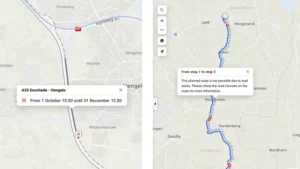
From pennant to traffic jam news
"If we had a 'traffic jam suspicion', we asked the telephone operator of Wegenwacht to listen to the talking posts. The sound of slowing down car wheels gave us an image of the tail of the traffic jam."
Arnoud Broekhuis
First traffic jam on Whit Monday in 1955
The phenomenon ‘traffic jam’ is now more than sixty years old. On Whit Monday, 1955, German tourists and Dutch road users met each other on the A12 at junction Oudenrijn. As mobility and car use increased, the likelihood of traffic jams also increased. As traffic jams increased, so did the need for information about them. This was not always easy, especially when the weather was bad. The unpredictability of traffic jams made them difficult to detect. Moreover, sources and means of communication were limited. In order to still have an overview of the situation on Dutch motorways, the Wegenwacht and the Algemene Verkeersdienst from Driebergen patrolled the area. Of course, there were far too few police-Porsches to continuously monitor all the roads. Especially for the underlying road network.
Together with TomTom and Simacan
Arnoud Broekhuis is Traffic Information Manager at the ANWB. He sketches the history of traffic jams and traffic information.
This might also interest you:

Transport Preparation
Successful logistics begins with strategic transport preparation. The Simacan platform revolutionizes traditional planning by integrating real-time data, intelligent validation, and seamless multi-planning capabilities. From vehicle

Maximizing APS investments with smart execution management
Optimizing APS with smart execution management. Traditional APS lacks real-time adaptability. Smart execution management enables continuous replanning, dynamic scheduling, and real-time adjustments, improving efficiency, reducing

